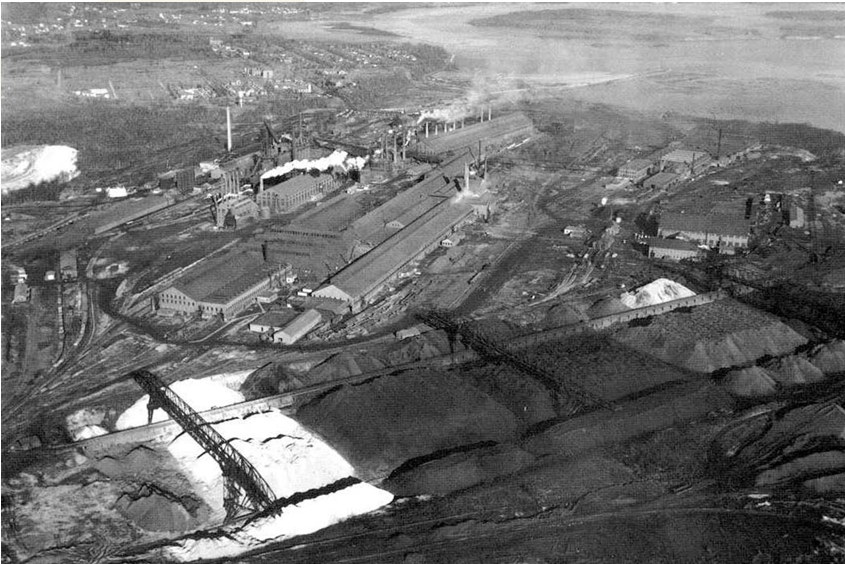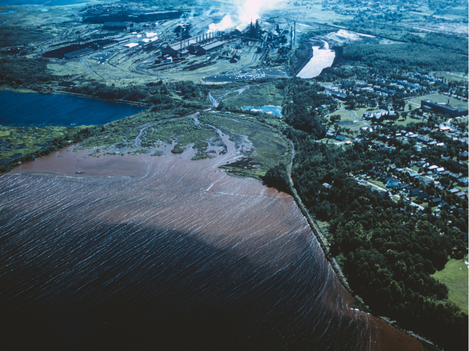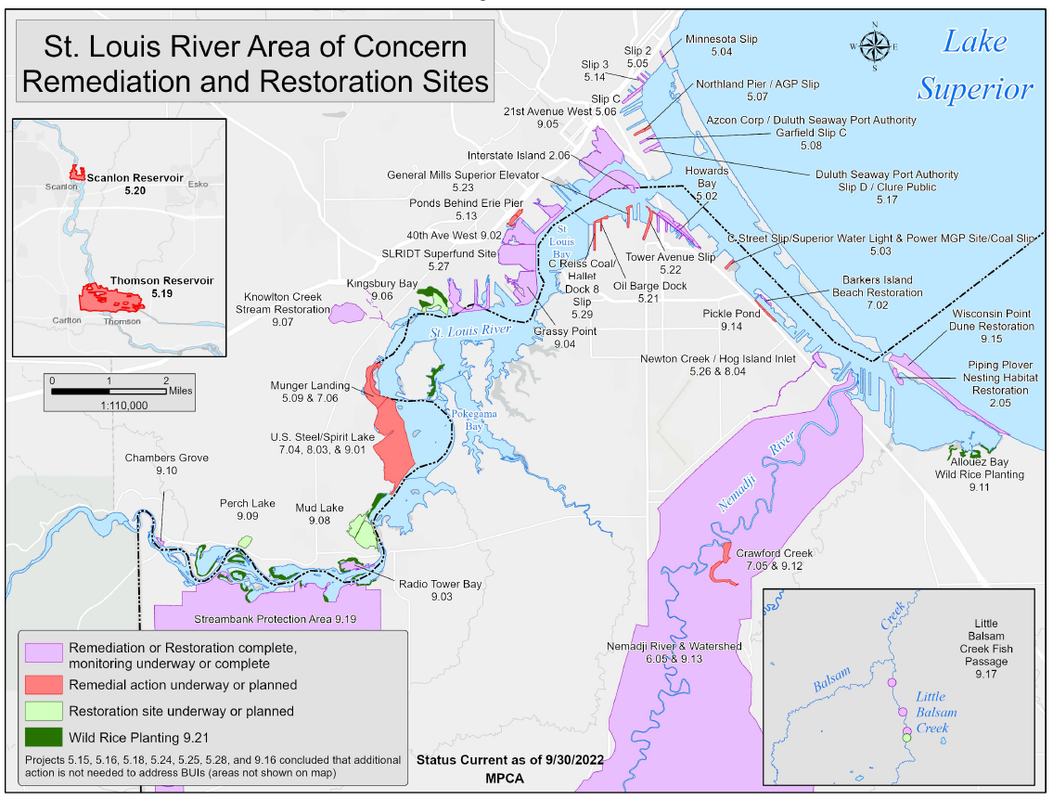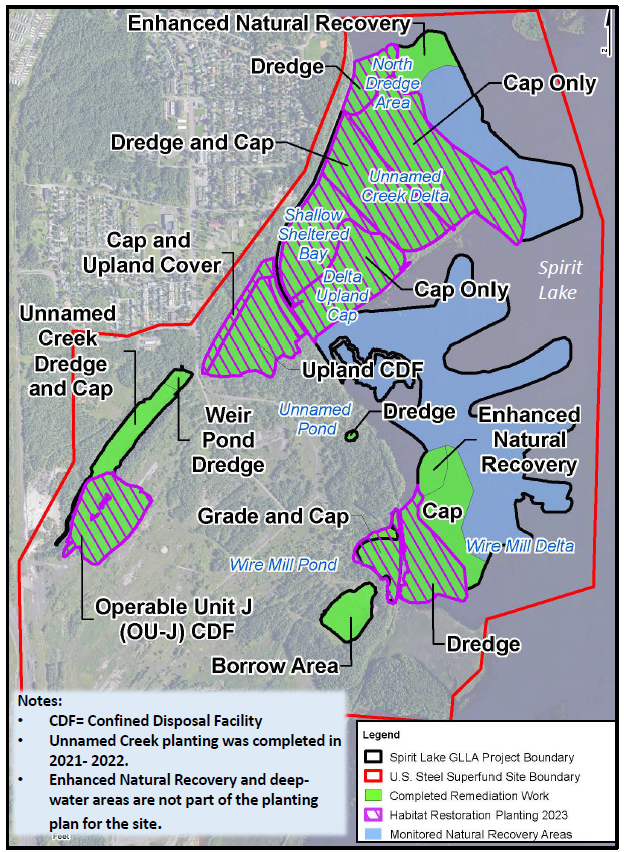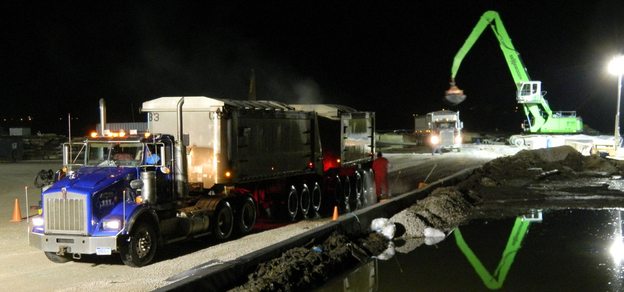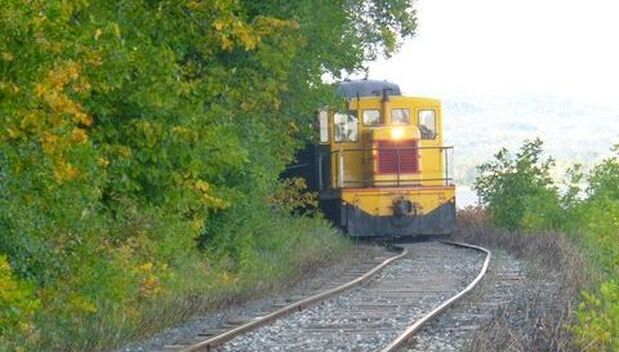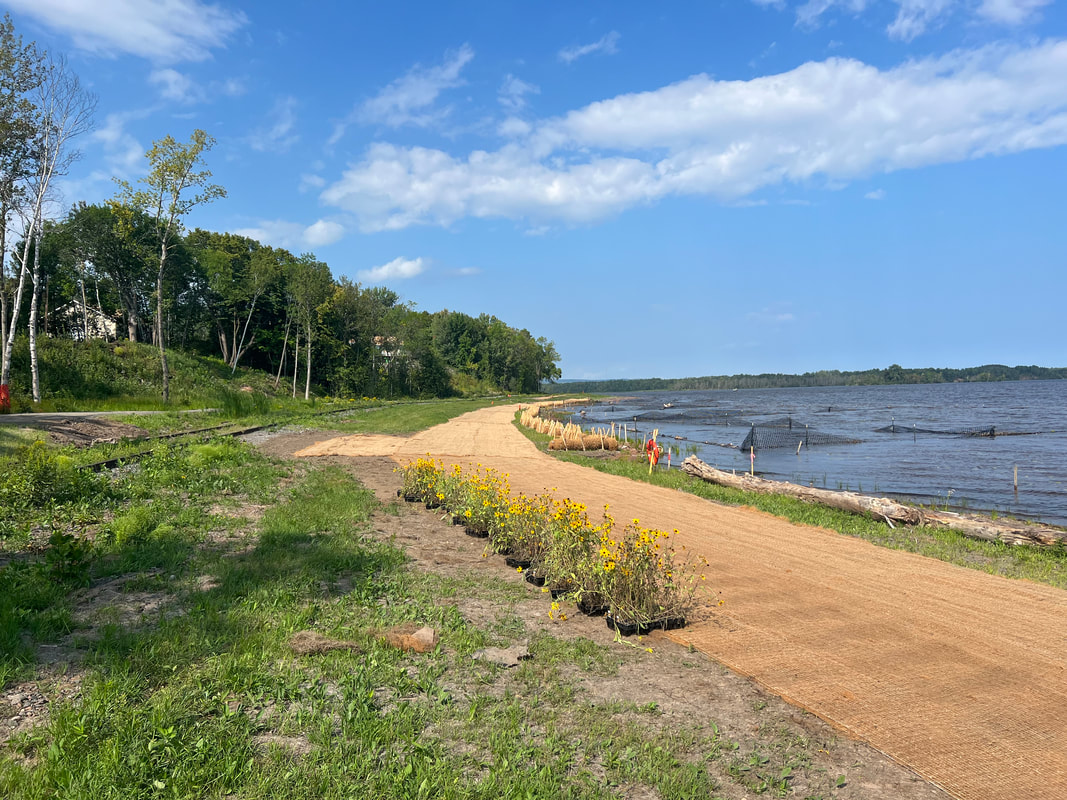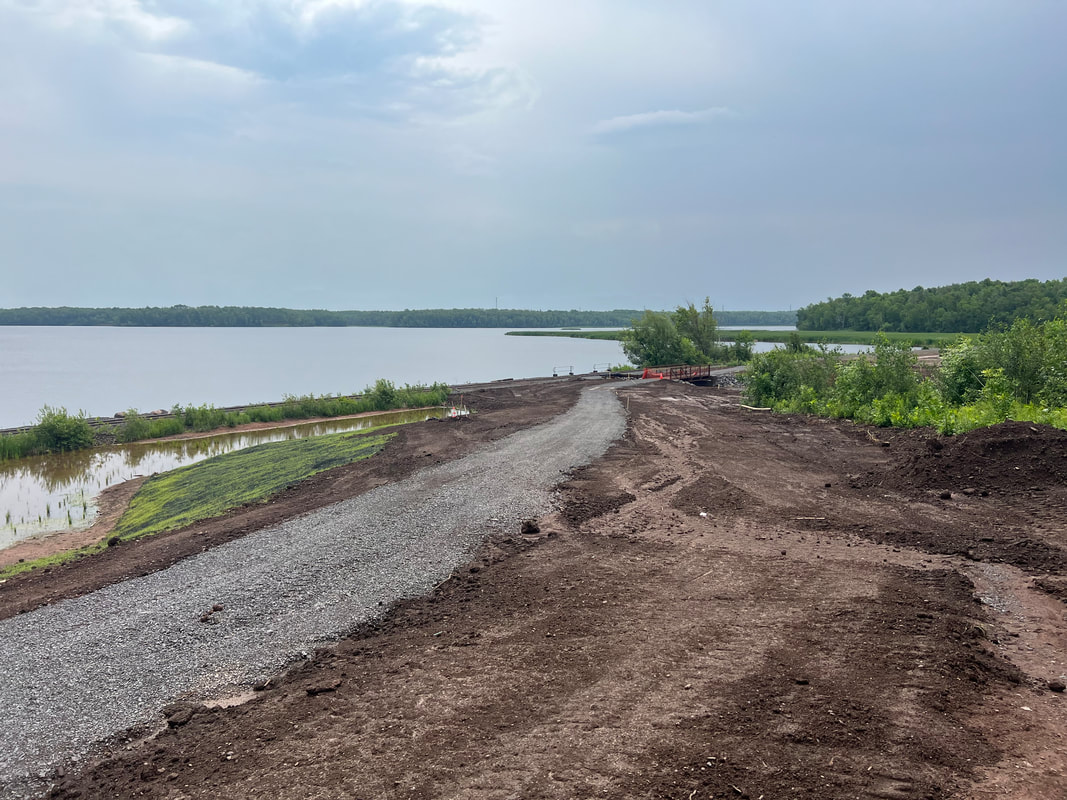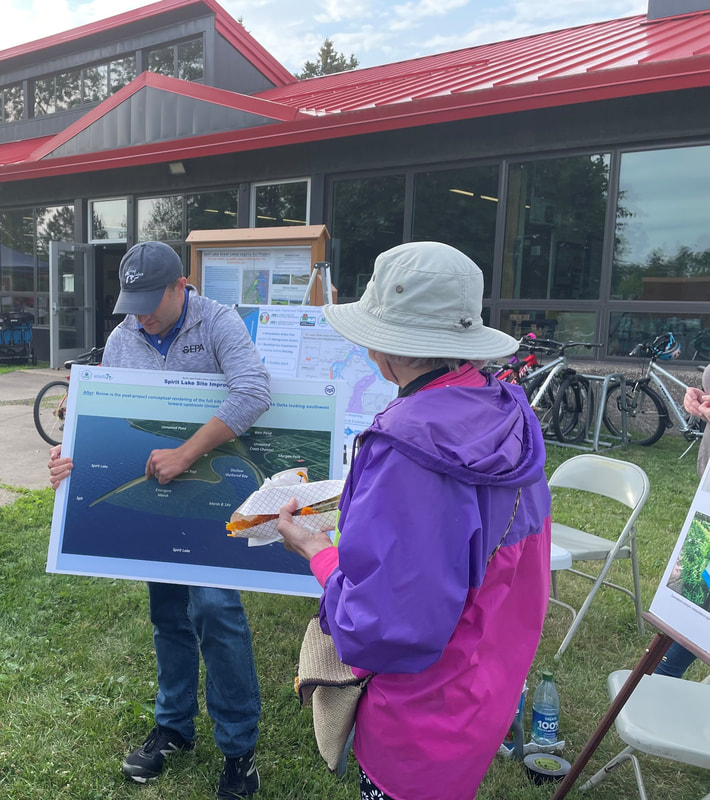I think we've had our most dramatic changes already. Individual sites will dramatically change as we remediate and restore them, so the habitat's going to be improved. And we’ll have more habitat available. So yeah, it’s primarily individual sites that you see the big changes on, but as a whole, the river's getting healthier all the time.
- Duluth resident, 2013
Site History
Spirit Lake is a large open area in the St. Louis River estuary. It is located near the site of the former U. S. Steel Duluth Works plant. The lake plays an important role for local people. The Lake Superior Mississippi Railroad operates a scenic passenger line that runs along the former U. S. Steel site with views of Spirit Lake. Spirit Island, a sacred place for the Fond du Lac Band of Lake Superior Chippewa, is located within Spirit Lake. The island was a stopping place in the southwest migration of the Anishinaabe people. Spirit Lake is also important to the Morgan Park neighborhood, which began as a company town for U. S. Steel plant workers. The plant shut down in 1981 and the property became a Superfund site soon after.
Although many remediation (cleanup) projects around the former plant have reduced risks to public health and the environment, contamination remains in Spirit Lake sediment near the U. S. Steel site. An investigation revealed that the contaminants include heavy metals, polychlorinated biphenyls (PCBs), polyaromatic hydrocarbons (PAHs), and dioxins. This cleanup of contaminated sediment is being conducted under the Great Lakes Legacy Act (GLLA) program. Once this GLLA sediment cleanup is completed, other areas of the U.S. Steel site will be remediated under the Superfund program if necessary.
Although many remediation (cleanup) projects around the former plant have reduced risks to public health and the environment, contamination remains in Spirit Lake sediment near the U. S. Steel site. An investigation revealed that the contaminants include heavy metals, polychlorinated biphenyls (PCBs), polyaromatic hydrocarbons (PAHs), and dioxins. This cleanup of contaminated sediment is being conducted under the Great Lakes Legacy Act (GLLA) program. Once this GLLA sediment cleanup is completed, other areas of the U.S. Steel site will be remediated under the Superfund program if necessary.
Location
The Spirit Lake/former U. S. Steel Duluth Works site is located near Spirit Lake and miles upstream of Lake Superior. The site is located in the Morgan Park neighborhood of Duluth, MN and is within the St. Louis River Area of Concern (AOC), the second largest U. S. AOC.
Schedule
This sediment remediation (cleanup) project is being conducted by the U.S. Environmental Protection Agency (EPA) and U.S. Steel through a voluntary Great Lakes Legacy Act partnership. Cleanup operations began in October 2020 and will take two to three field seasons to complete. A field season can last anywhere from 4-10 months and is determined by considerations like weather.
Cleanup Process
Sediment to be remediated: 1.3 million cubic yards (460,000 cubic yards removed; 850,000 cubic yards capped)
Contaminants of concern: Heavy metals, PCBs, PAHs, and dioxins
Method:
Partners: U. S. Environmental Protection Agency and U. S. Steel
Cost: $165 million
Note: In the 2022 final revised remedial design, the cleanup will incorporate the creation of a Shallow Sheltered Bay with deep-to-shallow water transitions throughout the site. Dredged sediment will be stored long-term on site in two Confined Disposal Facilities (CDFs).
Contaminants of concern: Heavy metals, PCBs, PAHs, and dioxins
Method:
- Dredging (removal of sediment)
- Capping (isolation of sediment from the environment)
- Long-term monitoring
Partners: U. S. Environmental Protection Agency and U. S. Steel
Cost: $165 million
Note: In the 2022 final revised remedial design, the cleanup will incorporate the creation of a Shallow Sheltered Bay with deep-to-shallow water transitions throughout the site. Dredged sediment will be stored long-term on site in two Confined Disposal Facilities (CDFs).
Construction Progress
Weekly photos of remediation and restoration activities on site are available on the EPA Spirit Lake Website. Hover over each photo below to learn more.
Short-term Disruptions
|
NOISE: Construction equipment with mufflers and muted back-up alarms may be used on site during night hours to reduce noise. The City of Duluth has noise ordinances that apply to construction sites and this project will be no exception.
LIGHT: With around-the-clock construction, there will be lighting needs at night. Shields, barriers, and directional flood lighting can reduce the impact of light pollution. TRUCK ROUTES: Although most of the sediment will be managed on-site in confined disposal facilities, large trucks and equipment will be entering and leaving the site on occasion. Trucks are expected to primarily access the site using an alternate access road south of Morgan Park. WILDLIFE: Construction is likely to affect ducks, turtles, frogs, and other wildlife that currently inhabit the site. The disruption will be temporary. After the restoration is complete, the wildlife will return to a much healthier environment free from contamination exposure. RAILROAD: The project team continues to coordinate with the Lake Superior & Mississippi Railroad (LSMRR) on operational schedules and potential impacts during construction. Impacts or closures may change based on field season or location of construction activities on site. The railroad will be restored to usable condition after the project so that the LSMRR can continue operations. |
Long-term Benefits
- The Spirit Lake cleanup will result in aquatic ecosystem improvement through the creation of new open water, increased fish spawning habitat and restored wetlands.
- Public access to the St. Louis River will also be improved with the creation of a pedestrian trail and greenspaces.
- The cleanup and restoration of the St. Louis River have contributed to community revitalization in Duluth. Learn about Duluth’s revitalization, including its economic growth and increased tourism.
- To learn more about the significant benefits enjoyed by communities in Great Lakes Areas of Concern after a cleanup, watch the Great Lakes Legacy Act video.
Community Involvement
|
Spirit Lake is a sacred place for the Fond du Lac Band and an asset for many nearby Duluth residents, especially those living in Morgan Park. EPA continues to coordinate with project stakeholders on the development of outreach materials. An informational kiosk has been installed at the 88th Avenue West and Idaho Street site entrance and outside the Morgan Park Community Center. Weekly photos of construction progress are also available on the EPA Spirit Lake Website.
Contact U. S. EPA to provide input on the project, ask questions, or to coordinate the project with community events on the river.
October 25, 2023 Fall Media Event
August 1, 2023 Public Outreach Event at Morgan Park National Night Out
August 3, 2022 Public Outreach Event at Morgan Park National Night Out
May 19, 2022 Public Outreach Event at Morgan Park Community Center
March 4, 2020 Open house at Morgan Park Community Center April 4, 2017 Morgan Park meeting at Morgan Park Community Center
August 25, 2016 U. S. Steel public meeting at Denfeld High School December 2, 2014 Morgan Park meeting at Morgan Park Community Center
|
Learn about Spirit Island
- The Spirit Lake project site is located near Spirit Island, a culturally significant tribal area.
More Information
Documents and Resources
Great Lakes Areas of Concern: Six Strategies to Support Community Revitalization (PDF, 8p, 987KB) 2024
Spirit Lake Informational Kiosk Poster (PDF, 1p, 3.2MB) September 2023
Spirit Lake Informational Kiosk Poster (PDF, 1p, 1.8MB) March 2023
Duluth’s Revitalization: The St. Louis River Area of Concern (video, 5:20) 2022
Spirit Lake Fall 2022 Fact Sheet (PDF, 2p, 780KB) October 2022
Spirit Lake Informational Kiosk Poster (PDF, 1p, 1.5MB) October 2022
Spirit Lake GLLA Project Traffic Update (PDF, 1 p, 233KB) August 2022
Spirit Lake Informational Kiosk Poster (PDF, 1p, 2.9MB) March 2022
Spirit Lake December 2021 Fact Sheet (PDF, 2p, 639KB) December 2021
Spirit Lake Informational Kiosk Poster (PDF, 1p, 2.2MB) August 2021
Spirit Lake Summer 2021 Fact Sheet (PDF, 2p, 771KB) July 2021
Spirit Lake FAQs (PDF, 2p, 1.2MB) December 2020
Spirit Lake FAQs (PDF, 12p, 3.9MB) March 2017
Spirit Lake Proposed Plan Fact Sheet (PDF, 2p, 227KB) August 2016
Public Meeting Invitation (PDF, 2p, 294KB) August 2016
Addendum to feasibility study former U.S. Steel Duluth Works Spirit Lake sediment site (PDF, 30p, 2.67KB) December 2015
Outreach needs assessment for St. Louis River (PDF, 17p, 903KB) October 2013
U. S. Steel Spirit Lake site habitat wetland delineation (PDF, 82p, 31MB) April 2013
Former U. S. Steel Duluth Works Spirit Lake sediment remedial investigation report (PDF, 292p, 44MB) March 2013
Stakeholders
St. Louis River Alliance
Morgan Park Community Club
City of Duluth
Fond du Lac Band of Lake Superior Chippewa
Lake Superior & Mississippi Railroad
Wisconsin and Minnesota Sea Grant St. Louis River - Stories and Science
Minnesota Pollution Control Agency St. Louis River – U. S. Steel Superfund Site
Minnesota Department of Health Fish Consumption Guidance
Wisconsin Department of Natural Resources Area of Concern
U. S. Environmental Protection Agency
Great Lakes Areas of Concern: Six Strategies to Support Community Revitalization (PDF, 8p, 987KB) 2024
Spirit Lake Informational Kiosk Poster (PDF, 1p, 3.2MB) September 2023
Spirit Lake Informational Kiosk Poster (PDF, 1p, 1.8MB) March 2023
Duluth’s Revitalization: The St. Louis River Area of Concern (video, 5:20) 2022
Spirit Lake Fall 2022 Fact Sheet (PDF, 2p, 780KB) October 2022
Spirit Lake Informational Kiosk Poster (PDF, 1p, 1.5MB) October 2022
Spirit Lake GLLA Project Traffic Update (PDF, 1 p, 233KB) August 2022
Spirit Lake Informational Kiosk Poster (PDF, 1p, 2.9MB) March 2022
Spirit Lake December 2021 Fact Sheet (PDF, 2p, 639KB) December 2021
Spirit Lake Informational Kiosk Poster (PDF, 1p, 2.2MB) August 2021
Spirit Lake Summer 2021 Fact Sheet (PDF, 2p, 771KB) July 2021
Spirit Lake FAQs (PDF, 2p, 1.2MB) December 2020
Spirit Lake FAQs (PDF, 12p, 3.9MB) March 2017
Spirit Lake Proposed Plan Fact Sheet (PDF, 2p, 227KB) August 2016
Public Meeting Invitation (PDF, 2p, 294KB) August 2016
Addendum to feasibility study former U.S. Steel Duluth Works Spirit Lake sediment site (PDF, 30p, 2.67KB) December 2015
Outreach needs assessment for St. Louis River (PDF, 17p, 903KB) October 2013
U. S. Steel Spirit Lake site habitat wetland delineation (PDF, 82p, 31MB) April 2013
Former U. S. Steel Duluth Works Spirit Lake sediment remedial investigation report (PDF, 292p, 44MB) March 2013
Stakeholders
St. Louis River Alliance
Morgan Park Community Club
City of Duluth
Fond du Lac Band of Lake Superior Chippewa
Lake Superior & Mississippi Railroad
Wisconsin and Minnesota Sea Grant St. Louis River - Stories and Science
Minnesota Pollution Control Agency St. Louis River – U. S. Steel Superfund Site
Minnesota Department of Health Fish Consumption Guidance
Wisconsin Department of Natural Resources Area of Concern
U. S. Environmental Protection Agency
